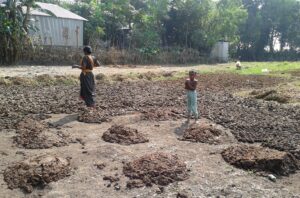SEI is working to raise awareness about improved manure management practices, build new knowledge, and remove barriers to adoption, with pilot projects in Vietnam and Bangladesh.

A woman and her child in Bangladesh lay out dung cakes to dry, to be used for fuel. Photo by Ngamnet AektasaengLivestock plays an important role in global food production and in agricultural and rural economies in many developing countries. Manure can also be a valuable resource, but it is often poorly managed, leading to an array of environmental problems and threatening public health.
As part of its global agriculture initiative, the Climate and Clean Air Coalition to Reduce Short-Lived Climate Pollutants (CCAC), in which SEI is an active partner, has launched a programme on livestock and manure management, aiming to reduce emissions while achieving development co-benefits.
The effort is led by the UN Food and Agriculture Organization (FAO) and Wageningen University, with regional centres in Southeast Asia, led by SEI’s Asia Centre; Africa, led by the International Livestock Research Institute (ILRI) in Kenya; and Latin America, led by the Tropical Agricultural Research and Higher Education Center (CATIE) in Costa Rica.
Together, the partners are conducting research; raising awareness of best practices among policy-makers, the private sector and farmers; establishing knowledge-sharing networks and rosters of experts; establishing an online repository of manure management information; and leading pilot projects.
As a key first step, the partners conducted a global assessment of manure management policies and practices, with policy reviews in 34 countries and more in-depth studies in Bangladesh, Vietnam, Ethiopia, Malawi, Argentina and Costa Rica. SEI led stakeholder consultations and policy surveys in nine countries, as well as the in-depth studies in Bangladesh and Vietnam.
“It is clear that there is much room for improvement,” says Ngamnet Aektasaeng, a research associate in SEI Asia, coordinator of the Asia Manure Knowledge Kiosk, and a co-author of the global report. “We need to raise awareness of manure’s potential as a resource, provide a supporting infrastructure to share knowledge about best practices, and develop customized solutions for farmers in different areas.”

A man in Bangladesh collects manure to put in a digester to make biogas. Photo by Ngamnet Aektasaeng
Follow-up studies and pilot programmes are now being launched in the focus countries. In Bangladesh, SEI is working on the development of a national policy for integrated manure management, while in Vietnam, SEI is focusing on increasing the use of manure, including bio-slurry.
The Asia team also participated in the Regional Meeting on Sustainable Dairy Development in Asia, held 23–26 March in Anand, India, which focused on establishing a strategic framework for sustainable dairy development in the region, preparing a plan of action, and setting up the Dairy Asia knowledge-sharing platform. CCAC also presented the results of the global assessment.
“There is a regional lack of awareness of the importance of integrated manure management in contributing to food security and reducing SLCPs, at both the policy and practice levels,” says Matthew Fielding, manager of the Asia Manure Knowledge Kiosk project. “Knowledge exchange platforms such as Dairy Asia are key in disseminating information and supporting changes in the perception of manure – from waste to fertilizer, energy source and much more.”
Read the global assessment report »
Learn more about the Climate and Clean Air Coalition Agriculture Initiative »

A farmer in Thailand washes down his pigs’ pen every day to clean out waste. Photo by Eddy Teenstra.
Design and development by Soapbox.

